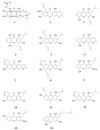Xanthones from the Pericarp of Garcinia mangostana
- PMID: 28441346
- PMCID: PMC6154529
- DOI: 10.3390/molecules22050683
Xanthones from the Pericarp of Garcinia mangostana
Abstract
Mangosteen (Garcinia mangostana L.) is one of the most popular tropical fruits (called the "Queen of Fruits"), and is a rich source of oxygenated and prenylated xanthone derivatives. In the present work, phytochemical investigation has resulted in one new prenylated xanthone and 13 known xanthones isolated from the pericarp of G. mangostana. Their structures were established by spectroscopic data analysis, including X-ray diffraction. The new one was further tested for cytotoxic activity against seven cancer cell lines (CNE-1, CNE-2, A549, H490, PC-3, SGC-7901, U87), displaying the half maximal inhibitory concentration (IC₅0) values 3.35, 4.01, 4.84, 7.84, 6.21, 8.09, and 6.39 μM, respectively. It is noteworthy that the new compound can promote CNE-2 cells apoptosis in late stage, having a remarkable inhibition effect on the side population growth of CNE-2 at 1.26 μM. The bioactive compound was also detected in extract from fresh mangosteen flesh, which indicated that the popular fruit could have potential cytotoxic activity for cancer cell lines.
Keywords: Garcinia mangostana; cell lines; cytotoxic; xanthone.
Conflict of interest statement
The authors declare no conflict of interest. The founding sponsors had no role in the design of the study; in the collection, analyses, or interpretation of data; in the writing of the manuscript, and in the decision to publish the results.
Figures




Similar articles
-
Mangostanaxanthone VII, a new cytotoxic xanthone from Garcinia mangostana.Z Naturforsch C J Biosci. 2018 Apr 25;73(5-6):185-189. doi: 10.1515/znc-2017-0122. Z Naturforsch C J Biosci. 2018. PMID: 29116938
-
New xanthones and cytotoxic constituents from Garcinia mangostana fruit hulls against human hepatocellular, breast, and colorectal cancer cell lines.J Ethnopharmacol. 2017 Feb 23;198:302-312. doi: 10.1016/j.jep.2017.01.030. Epub 2017 Jan 18. J Ethnopharmacol. 2017. PMID: 28108382
-
Two new prenylated xanthones and a new prenylated tetrahydroxanthone from the pericarp of Garcinia mangostana.Fitoterapia. 2010 Sep;81(6):595-9. doi: 10.1016/j.fitote.2010.02.002. Epub 2010 Feb 20. Fitoterapia. 2010. PMID: 20176087
-
Medicinal properties of mangosteen (Garcinia mangostana).Food Chem Toxicol. 2008 Oct;46(10):3227-39. doi: 10.1016/j.fct.2008.07.024. Epub 2008 Aug 6. Food Chem Toxicol. 2008. PMID: 18725264 Review.
-
Medicinal properties of mangosteen (Garcinia mangostana L.): A comprehensive update.Food Chem Toxicol. 2017 Nov;109(Pt 1):102-122. doi: 10.1016/j.fct.2017.08.021. Epub 2017 Aug 24. Food Chem Toxicol. 2017. PMID: 28842267 Review.
Cited by
-
Potency of Xanthone Derivatives from Garcinia mangostana L. for COVID-19 Treatment through Angiotensin-Converting Enzyme 2 and Main Protease Blockade: A Computational Study.Molecules. 2023 Jul 4;28(13):5187. doi: 10.3390/molecules28135187. Molecules. 2023. PMID: 37446849 Free PMC article.
-
Recent updates on metabolite composition and medicinal benefits of mangosteen plant.PeerJ. 2019 Jan 31;7:e6324. doi: 10.7717/peerj.6324. eCollection 2019. PeerJ. 2019. PMID: 30755827 Free PMC article.
-
2-Phenyl-4,4,5,5-tetramethylimidazoline-1-oxyl 3-oxide Radical (PTIO•) Trapping Activity and Mechanisms of 16 Phenolic Xanthones.Molecules. 2018 Jul 11;23(7):1692. doi: 10.3390/molecules23071692. Molecules. 2018. PMID: 29997352 Free PMC article.
-
Alpha and gamma mangostins inhibit wild-type B SARS-CoV-2 more effectively than the SARS-CoV-2 variants and the major target is unlikely the 3C-like protease.Heliyon. 2024 May 27;10(11):e31987. doi: 10.1016/j.heliyon.2024.e31987. eCollection 2024 Jun 15. Heliyon. 2024. PMID: 38867992 Free PMC article.
-
An Update on the Anticancer Activity of Xanthone Derivatives: A Review.Pharmaceuticals (Basel). 2021 Nov 11;14(11):1144. doi: 10.3390/ph14111144. Pharmaceuticals (Basel). 2021. PMID: 34832926 Free PMC article. Review.
References
MeSH terms
Substances
LinkOut - more resources
Full Text Sources
Other Literature Sources

